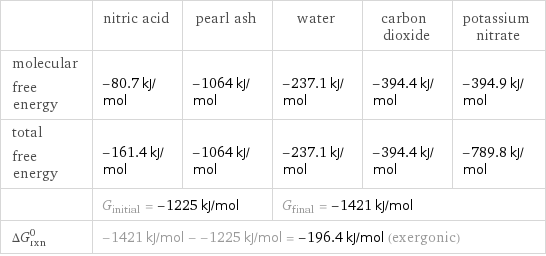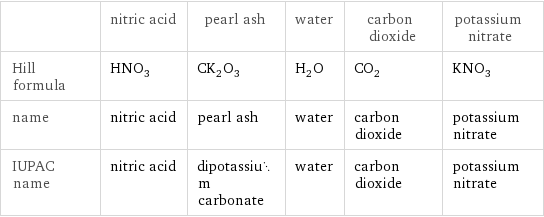Input interpretation

nitric acid + pearl ash ⟶ water + carbon dioxide + potassium nitrate
Balanced equation

Balance the chemical equation algebraically: + ⟶ + + Add stoichiometric coefficients, c_i, to the reactants and products: c_1 + c_2 ⟶ c_3 + c_4 + c_5 Set the number of atoms in the reactants equal to the number of atoms in the products for H, N, O, C and K: H: | c_1 = 2 c_3 N: | c_1 = c_5 O: | 3 c_1 + 3 c_2 = c_3 + 2 c_4 + 3 c_5 C: | c_2 = c_4 K: | 2 c_2 = c_5 Since the coefficients are relative quantities and underdetermined, choose a coefficient to set arbitrarily. To keep the coefficients small, the arbitrary value is ordinarily one. For instance, set c_2 = 1 and solve the system of equations for the remaining coefficients: c_1 = 2 c_2 = 1 c_3 = 1 c_4 = 1 c_5 = 2 Substitute the coefficients into the chemical reaction to obtain the balanced equation: Answer: | | 2 + ⟶ + + 2
Structures

+ ⟶ + +
Names

nitric acid + pearl ash ⟶ water + carbon dioxide + potassium nitrate
Reaction thermodynamics
Gibbs free energy

| nitric acid | pearl ash | water | carbon dioxide | potassium nitrate molecular free energy | -80.7 kJ/mol | -1064 kJ/mol | -237.1 kJ/mol | -394.4 kJ/mol | -394.9 kJ/mol total free energy | -161.4 kJ/mol | -1064 kJ/mol | -237.1 kJ/mol | -394.4 kJ/mol | -789.8 kJ/mol | G_initial = -1225 kJ/mol | | G_final = -1421 kJ/mol | | ΔG_rxn^0 | -1421 kJ/mol - -1225 kJ/mol = -196.4 kJ/mol (exergonic) | | | |
Equilibrium constant
![K_c = ([H2O] [CO2] [KNO3]^2)/([HNO3]^2 [K2CO3])](../image_source/9e58e0e0d17b77f0e1b08f2b09d98338.png)
K_c = ([H2O] [CO2] [KNO3]^2)/([HNO3]^2 [K2CO3])
Rate of reaction
![rate = -1/2 (Δ[HNO3])/(Δt) = -(Δ[K2CO3])/(Δt) = (Δ[H2O])/(Δt) = (Δ[CO2])/(Δt) = 1/2 (Δ[KNO3])/(Δt) (assuming constant volume and no accumulation of intermediates or side products)](../image_source/4007df88866d122ab4897b6ec16ff837.png)
rate = -1/2 (Δ[HNO3])/(Δt) = -(Δ[K2CO3])/(Δt) = (Δ[H2O])/(Δt) = (Δ[CO2])/(Δt) = 1/2 (Δ[KNO3])/(Δt) (assuming constant volume and no accumulation of intermediates or side products)
Chemical names and formulas

| nitric acid | pearl ash | water | carbon dioxide | potassium nitrate Hill formula | HNO_3 | CK_2O_3 | H_2O | CO_2 | KNO_3 name | nitric acid | pearl ash | water | carbon dioxide | potassium nitrate IUPAC name | nitric acid | dipotassium carbonate | water | carbon dioxide | potassium nitrate